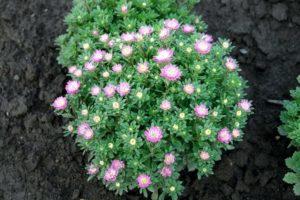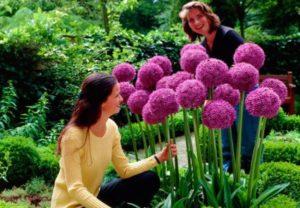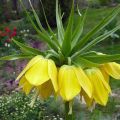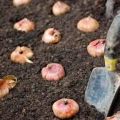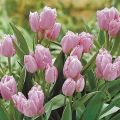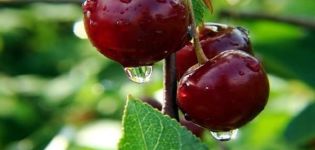Description and features of growing Japanese gladioli, planting and care
The gardener can decorate the site with the Japanese gladiolus throughout the season. At first, the beauty of the territory is given by the narrow xiphoid leaves of the plant. Then, from June to September, spike-shaped inflorescences of various colors begin to bloom. Further, there is a description and characteristics of crocosmia, information about plant species, methods of reproduction, characteristics of cultivation.
Description and characteristics
The Japanese gladiolus has several names: crocosmia, montbrecia, tritonia. The culture is native to South Africa. Belongs to the Iris family. The plant is tall. Peduncles reach a height of 1.5 meters. The leaves are narrow, shaped like swords. Their length is about 60 centimeters. The inflorescence is spike-shaped, consisting of star-funnel-shaped flowers. They have a variety of colors: scarlet, yellow, red, orange.
The buds bloom in early June. Flowering lasts until September. Japanese gladiolus propagates by seeds and bulbs. Each of them is capable of growing 3 peduncles.
Crocosmia is used for landscaping the site, used in cut form. In the water, the flower arrow is able to stand for 2 weeks without wilting. It can be used to decorate any bouquet.
Additional Information. "Crocosmia" is translated from Latin as "the smell of saffron." The plant is so named for the aroma emanating from dried flowers.
Plant species
Breeders have bred many species and varieties of Japanese gladiolus. They differ in the period of flowering, the height of the bushes, the color of the inflorescences.

Panicle crocosmia
The bushes of the Japanese gladiolus reach a height of 1.5 meters. At the top of the flower arrow, buds of bright orange color are formed. They begin to bloom in June.
Lucifer
The flower arrow of this hybrid reaches a height of 1.5 meters. Peduncles with scarlet or red paniculate inflorescences give a unique look to the bush. The Japanese gladiolus Lucifer is characterized by increased frost resistance. In regions with a temperate climate, bulbs do not need to be dug up in the fall.
Star of the East
Star of the East is one of the spectacular crocosmia varieties. Blooms late. The height of the bush is about 1 meter. The inflorescences consist of apricot-orange buds. Large flowers with a diameter of 10 centimeters are star-shaped.The frost resistance of the Star of the East is low.

Norwich canary
The bushes of the Japanese gladiolus variety Norwich Canary reach a height of 60 centimeters. On strong peduncles, flowers of a bright yellow color are formed. The buds open gradually, starting from the bottom.
Emily McKenzie
Montbrecia EmilyMcKenzie reaches a height of 60 centimeters. Spike-shaped inflorescences consist of brown-orange flowers. There is a bright orange spot at the base of the bud. The plant safely tolerates temperature fluctuations. Blooms late.
Reproduction methods
A gardener can breed Japanese gladiolus on the site in 2 ways: seeds and bulbs. When breeding hybrids with the first option, parental traits may not be preserved.
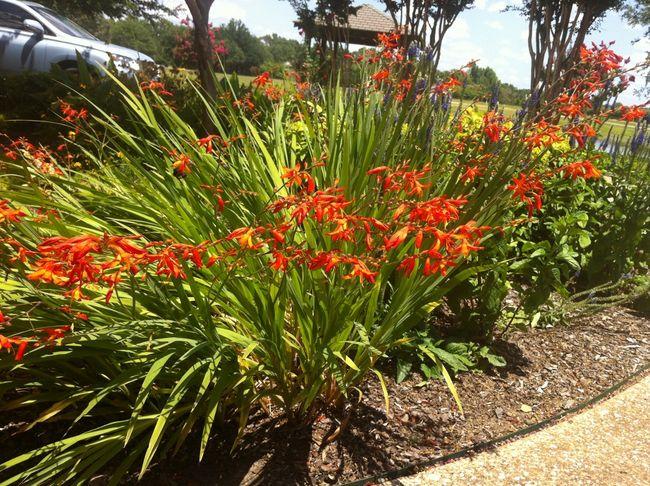
Seeds
The procedure is carried out in late winter or early spring. The seeds are soaked in warm water for a day. Then they are sown in a container with low sides. The substrate is selected loose, breathable. It can be prepared independently from peat, turf, humus, river sand.
The box with crops is covered with a transparent film, placed in a warm place. When the first shoots appear, the shelter is removed. Care consists in timely watering, loosening the soil.
After the appearance of a pair of true leaves, the plants dive. Use small pots for transplanting. The grown bushes are planted in open ground, having previously hardened. Crocosmia will not bloom in the year of planting.
Bulbs
During the season, children grow around the bulb. They can be detached and dropped off separately. Flowering will come next year. If young bulbs are not periodically separated, the mother bush will become too thickened, the inflorescences may become smaller.
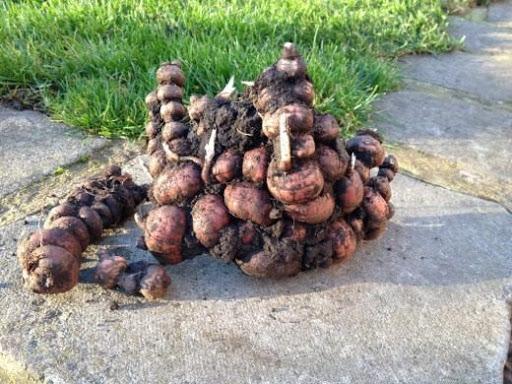
The parent corm will continue to develop after the procedure. Children are planted first in pots or immediately in open ground.
Growing features
Crocosmia is planted on the site with bulbs. Adults will bloom this year, the young will release a flower arrow only next season.
Selection and preparation of planting material
Bulbs must be dry, clean and free from dents or damage. They are taken out of the basement a month before planting, the husks are removed. For disinfection, the bulbs are placed in a solution of potassium permanganate. The procedure is carried out 2 hours before planting in the ground.
Landing dates
Japanese gladiolus is planted on the site in the spring, at the end of April or in the first decade of May. The soil should warm up to 6-10 ° C.

Preparation and selection of a landing site
The territory for crocosmia is selected well-lit by the sun. Otherwise, the flower arrow will grow thin, weak. Groundwater should be low. The substrate is selected fertile, air and water permeable. The plot has been prepared since autumn. They dig up the earth, bring in nutrients. 2 buckets of humus mixed with 40 grams of superphosphate are used per 1 square meter of area. In the spring, nitrogen can be added to the ground before planting.
Planting scheme and depth
Small bulbs are planted to a depth of 4-6 centimeters. For large planting material, pits are pulled out with a depth of 8-15 centimeters. Landing is done as follows:
- pull out grooves 15 centimeters deep;
- the bottom is filled with a light fertile substrate;
- spread the bulbs at a distance of 10-15 centimeters;
- watered;
- fall asleep with a substrate.
The spacing between rows is 25-30 centimeters.
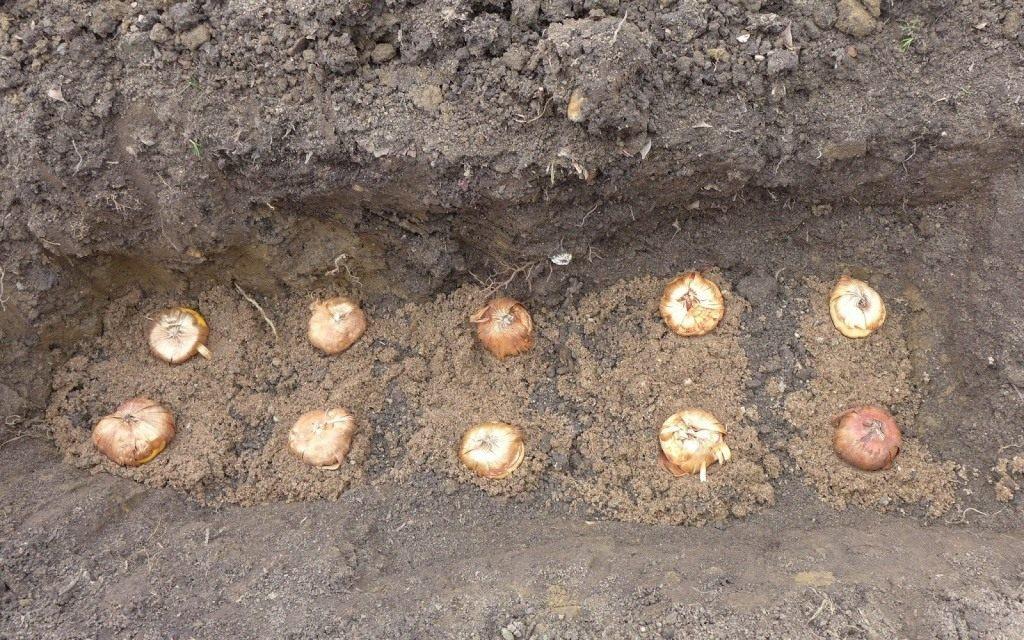
Features of flower care
In order for the bushes to bloom every year abundantly and for a long time, you need to correctly carry out agrotechnical measures. Care consists in timely watering, fertilization, loosening the soil. Flower arrows of tall crocosmies need to be tied up. This is done to prevent damage to the peduncles. For the winter, the bulbs are dug up, since they can freeze out in the harsh winter.
How to water the plant?
The land is irrigated as needed.The top layer of soil must have time to dry out. In waterlogged soil, pathogenic microorganisms can form that negatively affect the bulbs. If the soil is not irrigated in time, the flowers will begin to wither and fall prematurely. They use warm, settled water.
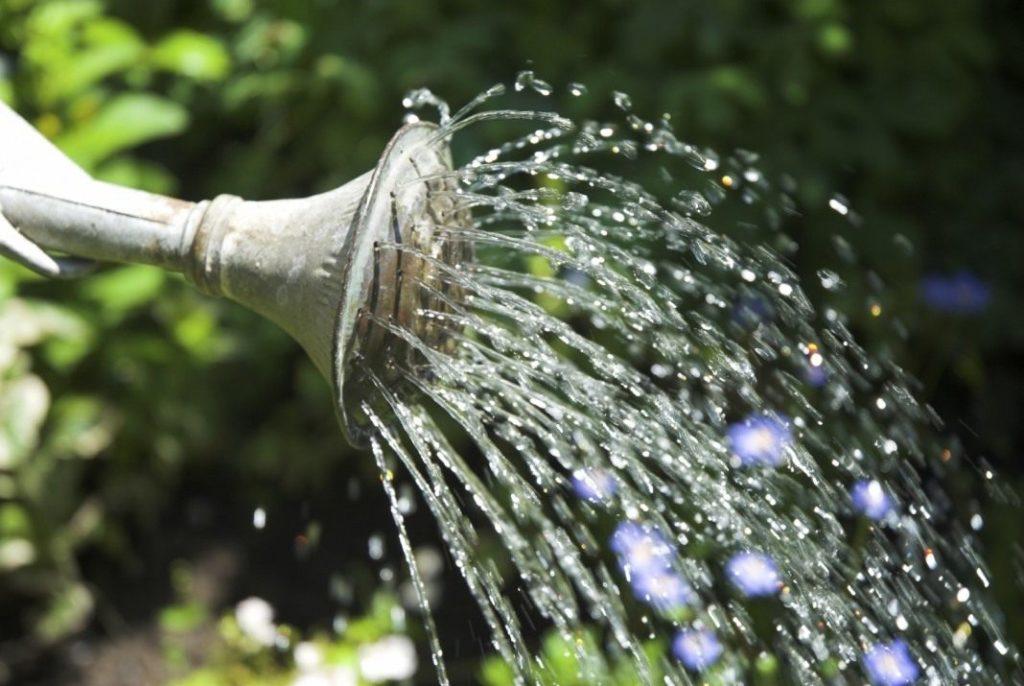
Fertilization
In order for the bushes of the Japanese gladiolus to grow powerful, and the flowering is abundant and long, the soil must be fertilized several times per season. Complex mineral substances are introduced in the spring. Potash fertilizers are used before flowering. Mullein can be added in late summer.
Important! Top dressing is applied to moistened soil, otherwise the root system may be damaged by salts.
Loosening the soil
After each watering, you need to loosen the soil. The procedure helps to retain moisture. In addition, loosening prevents the formation of a crust on the surface of the soil. It prevents water and moisture from accessing the bulb. Loosening also removes weeds - possible vectors of diseases and pests.
Garter rules
Low-growing varieties do not need a garter. It may only be required for crocosmia, in which the flower arrow reaches a height of 1.5 meters. Peduncles sag and break when grown in regions with strong gusts of wind. Therefore, in the summer they are tied to the support with ropes made of natural material.

Preparing for winter
In areas with severe winters, the bulbs are dug up, otherwise they will freeze. The procedure is carried out no earlier than mid-autumn. Even after flowering, while in the ground, the bulbs grow. If they are dug up prematurely, they will not be able to collect the necessary nutrients.
After digging, the bulbs of the Japanese gladiolus are thoroughly dried and placed in a cool room. On insufficiently dry material, there is a possibility of the formation of putrefactive microorganisms. In the southern regions, crocosmia can winter in the ground. In late autumn, the dry above-ground part of the plant is removed. Then the soil is covered with sawdust, spruce branches.
Diseases and pests
In unfavorable conditions, crocosmia can be affected by diseases and pests.
- Fusarium. The leaves affected by the disease begin to turn yellow and dry out. Peduncles become weaker, bent. The buds are deformed, their color changes.
- Gray rot. Bulb disease is affected. A gray coating appears on them.
- Herbiness. The leaf plates turn yellow and dry. It is a viral infection that has no cure. Bushes are pulled out and destroyed, the earth is treated with chemicals.
- Thrips. Insects suck the cell sap from the leaves, weakening the plants. Over time, the leaf plates dry out, the flowers are deformed.
- Spider mite. Pests appear on the Japanese gladiolus during a prolonged drought. Insects entangle the plant with cobwebs, suck out the juice.
- Medvedka. Pests eat the bulbs. To destroy the bear, special traps are made.
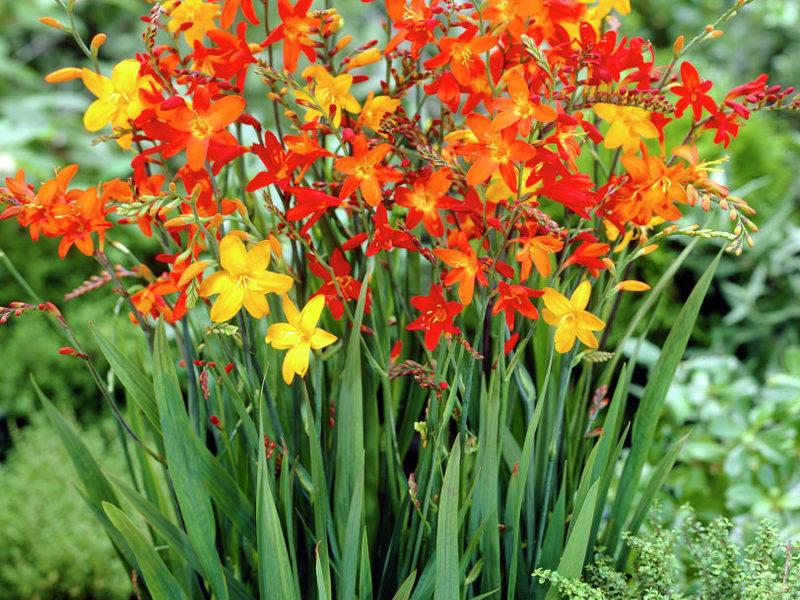
For the prevention and treatment of Japanese gladiolus from diseases, fungicides are used. Insects are eliminated by spraying with insecticides.
Note! Chemical treatment should not be carried out during the flowering period, otherwise beneficial insects that carry nectar may die.
Application in landscape design
Tall crocosmia varieties are planted next to low ornamental shrubs. Low bushes are planted in a mixborder. Montbrecia goes well with ornamental grasses, daylilies, gailardia, knifofia, spray chrysanthemums. Crocosmia will look spectacular against the background of conifers. Japanese gladiolus is able to emphasize the beauty of other plants, and can itself be a bright spot in the composition.
Cleaning and storage of bulbs
Dig up planting material before the onset of frost. The longer the bulb lies in the ground, the more nutrients it will absorb. Cleaning is carried out in dry weather.Corms are carefully dried, otherwise they can rot in winter. Store them in a dry, cool basement with good ventilation. Bulbs should be inspected during the winter to discard rotten ones. All planting material can be infected from one corm affected by pathogenic microorganisms.
Where to buy Chinese gladioli bulbs?
Planting material is purchased at flower shops. In spring, a large assortment of flowers appears in them, including crocosmia bulbs. They must be healthy, free from dents, stains, and other signs of disease. In addition, planting material is purchased via the Internet. Various sites offer to order Japanese gladiolus bulbs from them. Before making a purchase, you need to read the reviews of the sellers.
